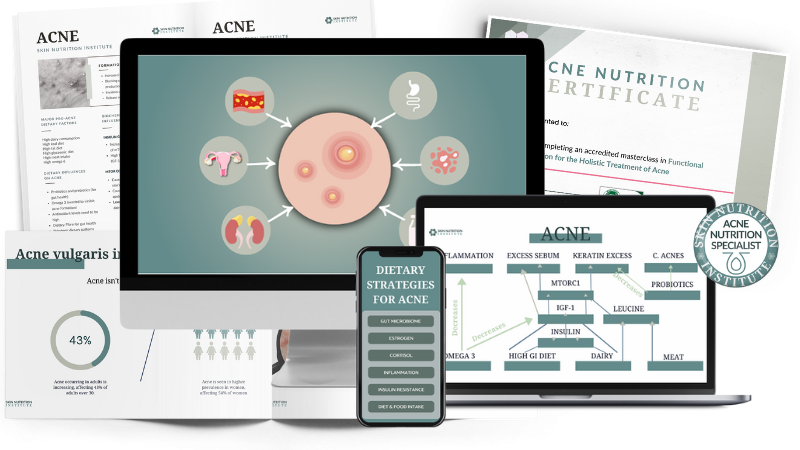The Ultimate A-Z Skin Nutrition Glossary
Be the smartest skin nutrition expert in the room with this scientific research at your fingertips.
Click a letter to jump to that section 👇🏼
Acne
Advanced Glycation End-Products (AGEs)
Harmful compounds formed when sugars bind to proteins, lipids, or DNA, leading to oxidative stress, inflammation, and accelerated skin ageing by damaging collagen and elastin.
Blog posts:
What Are AGEs? The Skin-Ageing Effects of Glycation
Endogenous Glycation: The Inside-Out Cause of Skin Ageing
Blog posts:
What Are AGEs? The Skin-Ageing Effects of Glycation
Endogenous Glycation: The Inside-Out Cause of Skin Ageing
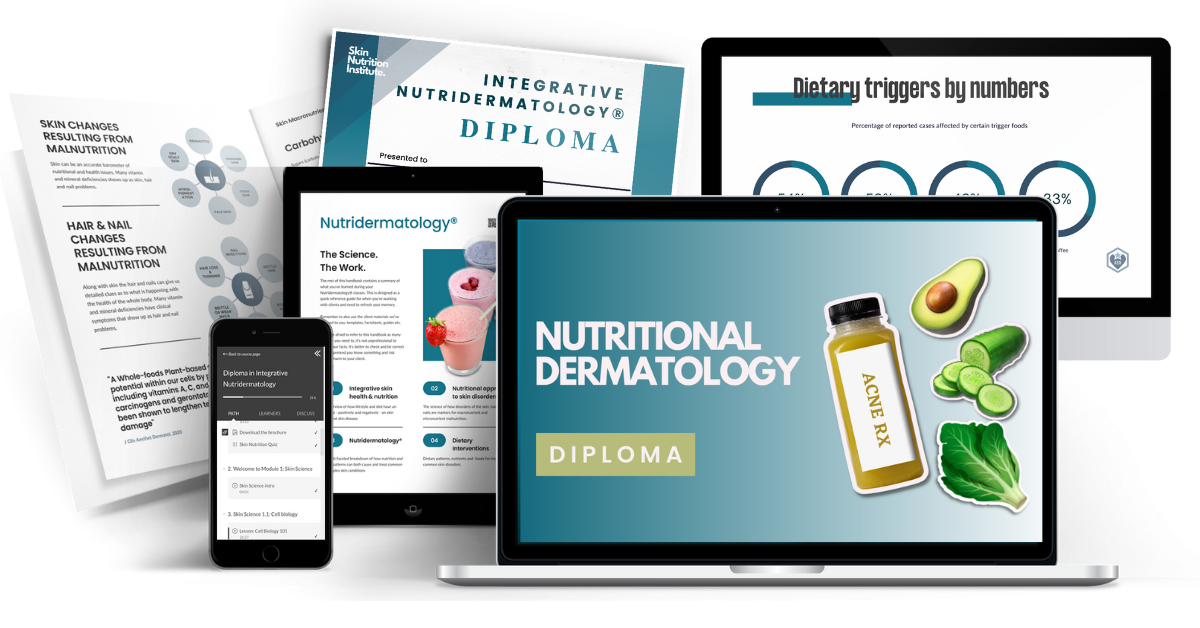
AMPs
Small, naturally occurring proteins produced by the skin and immune cells that defend against harmful bacteria, fungi, and viruses while supporting the balance of beneficial microbes and maintaining the skin’s barrier integrity. Read more:
Blog posts:
Antimicrobial Peptides: Nature’s Intelligent Skin Defence
Blog posts:
Antimicrobial Peptides: Nature’s Intelligent Skin Defence
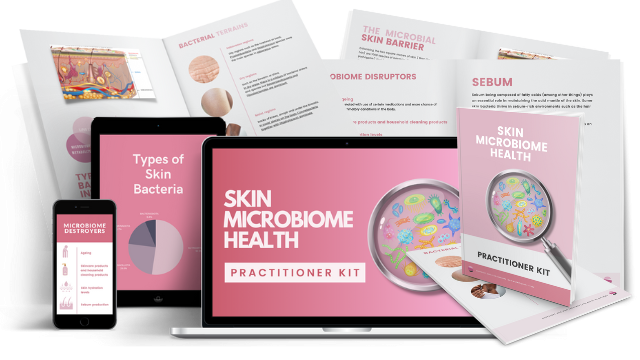
Amino Acids
Amino acids are the building blocks of proteins, including collagen and elastin, essential for skin structure, repair, and overall health. Read more:
Blog posts:
Amino Acids: The Plant-Origin Building Blocks of Collagen and Skin Health
Blog posts:
Amino Acids: The Plant-Origin Building Blocks of Collagen and Skin Health
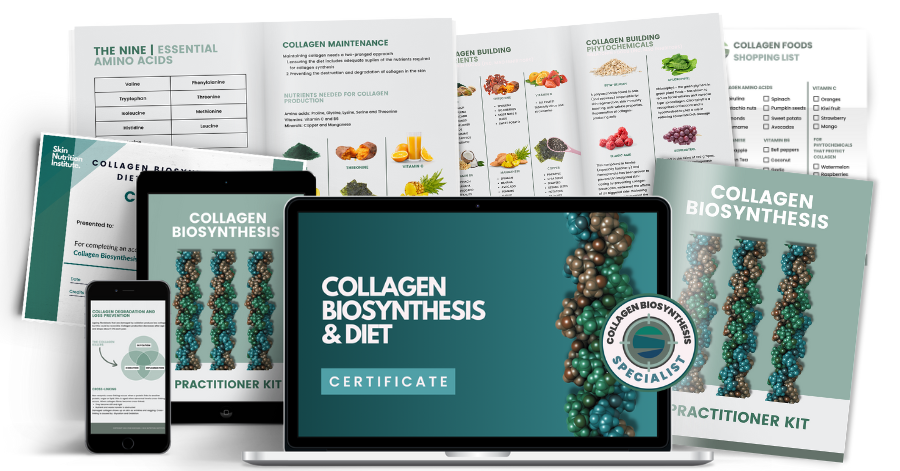
Anthocyanins
Potent antioxidants found in blue, black and purple foods. Read more:
Blog posts:
How Anthocyanins Promote Skin Health: Insights for Skincare Professional
Blog posts:
How Anthocyanins Promote Skin Health: Insights for Skincare Professional

Antioxidants
Molecules that protect the body’s cells from damage caused by free radicals, helping to reduce inflammation, prevent premature ageing, and support overall skin health. Read more:
Blog Posts:
Which antioxidants from fruits can reduce oxidative damage?
Why Professionals Need Training in Functional Nutrition Strategies for UV-Ageing & Sun Damage Repair
Cacao's Role in Promoting Skin Health: A Comprehensive Guide
Blog Posts:
Which antioxidants from fruits can reduce oxidative damage?
Why Professionals Need Training in Functional Nutrition Strategies for UV-Ageing & Sun Damage Repair
Cacao's Role in Promoting Skin Health: A Comprehensive Guide

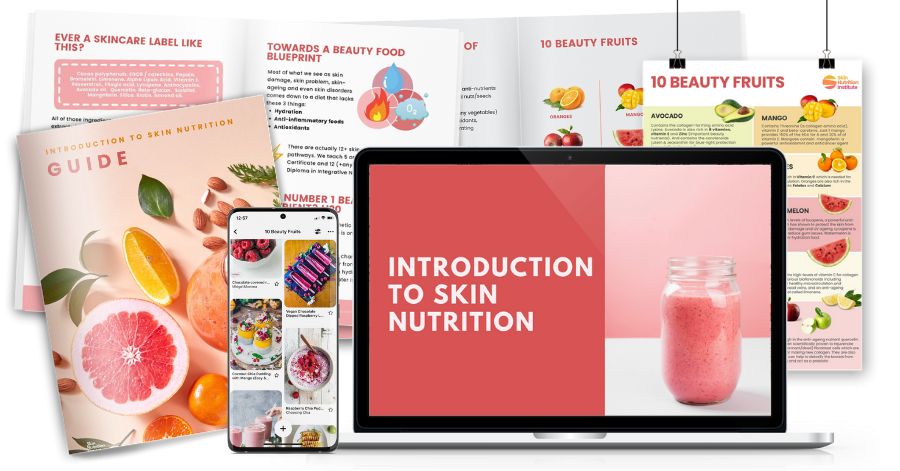
Aquaporins
Protein channels in cell membranes that regulate the flow of water and small solutes, helping to maintain optimal skin hydration and barrier function. Read more:
Blog posts:
Aquaporins: The Skin’s Natural Hydration Channels
Hydrate Your Skin from Within: The Science of the Skin Hydration Diet
Blog posts:
Aquaporins: The Skin’s Natural Hydration Channels
Hydrate Your Skin from Within: The Science of the Skin Hydration Diet

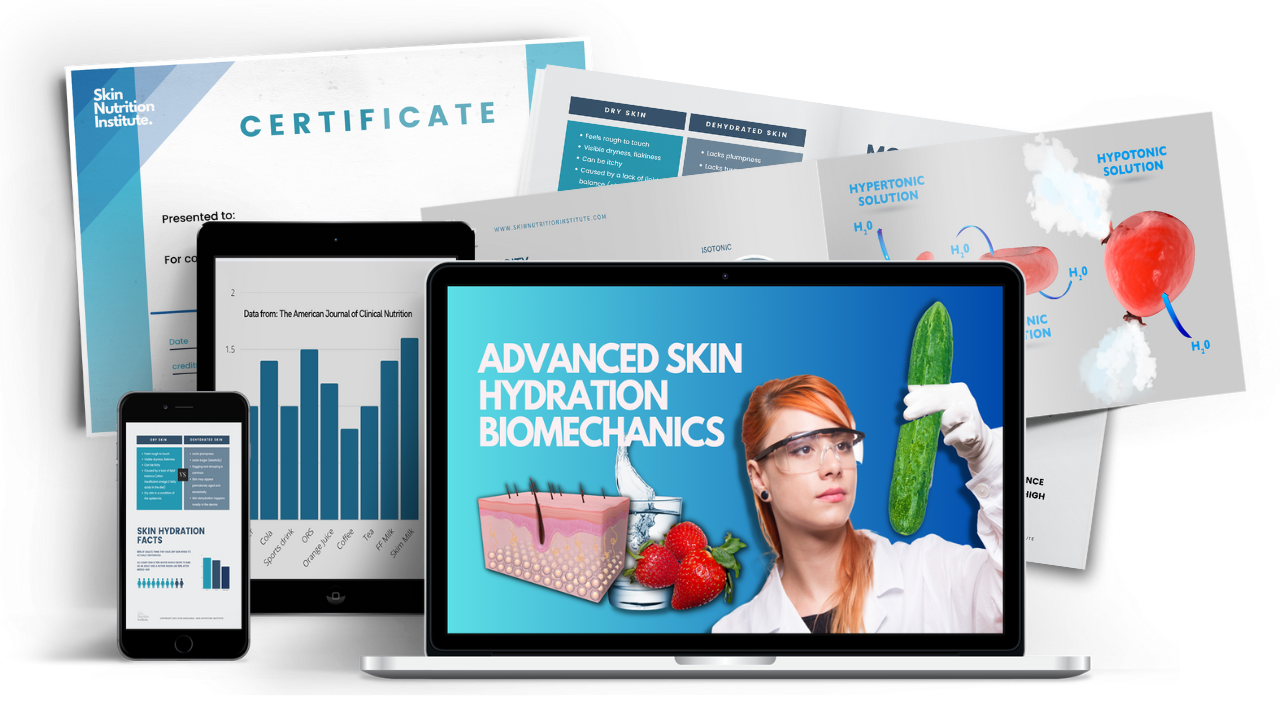
Beverage Hydration Index
A measure of how effectively a drink is retained in the body compared to water, indicating its impact on overall and cellular hydration. Read more:
Blog posts:
Beverage Hydration Index: Drinks That Truly Hydrate Your Skin
Blog posts:
Beverage Hydration Index: Drinks That Truly Hydrate Your Skin


Biotin
A water-soluble B vitamin that functions as a coenzyme in fatty acid synthesis, amino acid metabolism, and energy production. It supports keratin infrastructure, making it essential for healthy skin, hair, and nails. Read more:
Blog posts:
Can Raw Eggs Cause Brittle Nails? The Truth About Avidin and Biotin Deficiency
Blog posts:
Can Raw Eggs Cause Brittle Nails? The Truth About Avidin and Biotin Deficiency
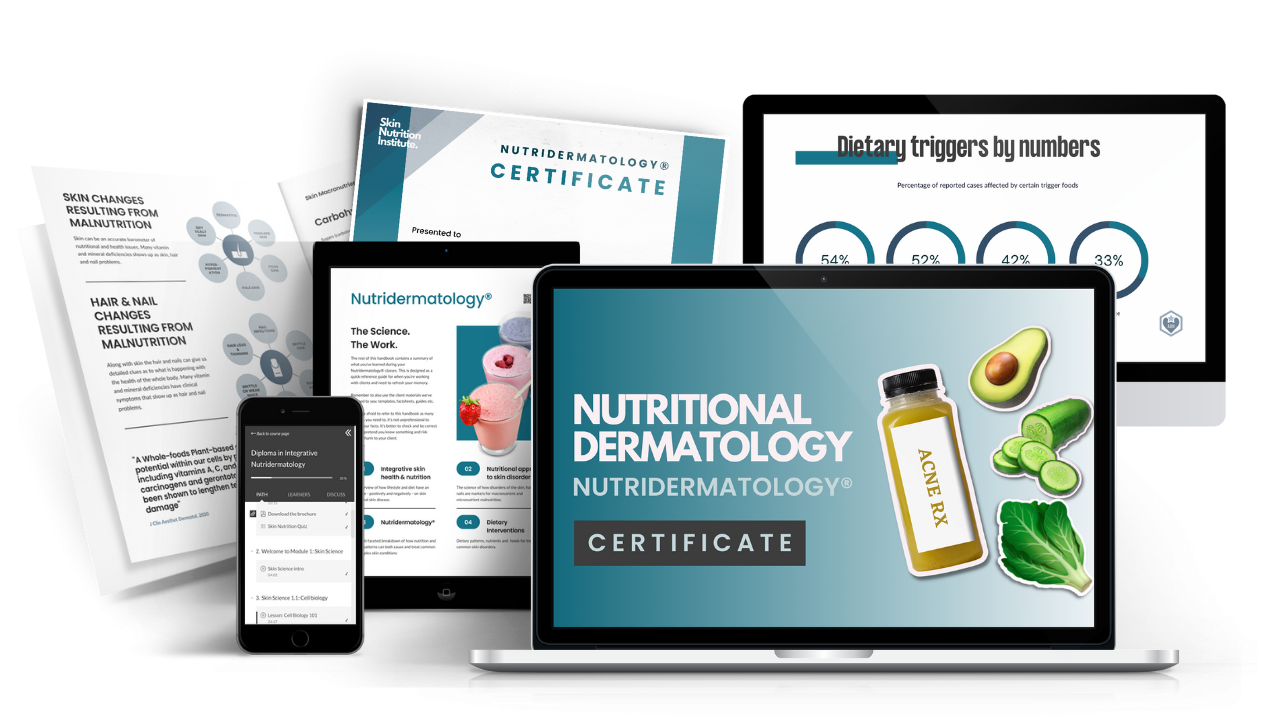

Collagen
An important protein. There are 4 types of Collagen and 1 of them is essential for skin-health and anti-ageing.
Blog posts:
What is skin collagen
Skin Collagen Foods: boosting collagen with plant-based nutrition and diet
Cacao's Role in Promoting Skin Health: A Comprehensive Guide
Blog posts:
What is skin collagen
Skin Collagen Foods: boosting collagen with plant-based nutrition and diet
Cacao's Role in Promoting Skin Health: A Comprehensive Guide

DAO
Diamine Oxidase (DAO) is an enzyme that breaks down histamine in the body, helping regulate inflammation, reduce skin redness, and support gut and skin health. Read more:
Blog posts:
Histamine, DAO and Skin Health: A Practitioner’s Guide
Blog posts:
Histamine, DAO and Skin Health: A Practitioner’s Guide


DHEA
Dehydroepiandrosterone (DHEA) is made in the adrenal glands that sit
on top of the kidneys. DHEA is know as ‘the youth hormone’ and it’s
involved in the production of oestrogen and testosterone. Levels decline
with age. Read more:
Blog post:
Skin-Ageing Hormones: What Every Skin-Health Practitioner Needs to Know
Blog post:
Skin-Ageing Hormones: What Every Skin-Health Practitioner Needs to Know

Eczema
An itchy skin disorder with food-intolerance connections
Blog posts:
Filaggrin Foods: Treating eczema with diet
Blog posts:
Filaggrin Foods: Treating eczema with diet

Fibroblasts
Fibroblasts are specialized cells in the dermis that produce collagen, elastin, and other extracellular matrix proteins, supporting skin structure, elasticity, and repair. Read more:
Blog Posts:
Fibroblasts: The Collagen-Forming Cells That Keep Your Skin Firm
Blog Posts:
Fibroblasts: The Collagen-Forming Cells That Keep Your Skin Firm

Free Water Reserve (FWR)
The amount of water remaining in the body and cells after essential losses, reflecting true cellular hydration and skin health.
Blog posts:
Aquaporins: The Skin’s Natural Hydration Channels
Hydrate Your Skin from Within: The Science of the Skin Hydration Diet
The Science of Skin Hydration: Free Water Reserve Demystified
Blog posts:
Aquaporins: The Skin’s Natural Hydration Channels
Hydrate Your Skin from Within: The Science of the Skin Hydration Diet
The Science of Skin Hydration: Free Water Reserve Demystified


Glycaemic Index & Glycaemic Load
The Glycaemic Index measures how quickly carbohydrate-containing foods raise blood glucose levels after eating. Foods with a high GI cause rapid spikes in blood sugar, while low-GI foods release glucose more slowly, helping to maintain balance and reduce glycation. Read more.
Blog Posts:
Glycation: How Sugar Ages Your Skin and Destroys Collagen
Endogenous Glycation: The Inside-Out Cause of Skin Ageing
Blog Posts:
Glycation: How Sugar Ages Your Skin and Destroys Collagen
Endogenous Glycation: The Inside-Out Cause of Skin Ageing


Glycation
Glycation is a chemical reaction where sugars bind to proteins, lipids, or DNA, forming harmful molecules called AGEs that accelerate skin ageing and loss of elasticity. Read more:
Blog Posts:
Glycation: How Sugar Ages Your Skin and Destroys Collagen
Endogenous Glycation: The Inside-Out Cause of Skin Ageing
Blog Posts:
Glycation: How Sugar Ages Your Skin and Destroys Collagen
Endogenous Glycation: The Inside-Out Cause of Skin Ageing


Hormones
Hormones are chemical messengers in the body that regulate processes like skin health, oil production, collagen synthesis, and cellular repair. Read more:
Blog Posts:
Skin-Ageing Hormones: What Every Skin-Health Practitioner Needs to Know
Blog Posts:
Skin-Ageing Hormones: What Every Skin-Health Practitioner Needs to Know

Hydration
The process of supplying water to the body and cells to maintain optimal physiological function, skin health and cellular balance. Read more:
Blog posts:
The Sodium Pump: The Unsung Hero of Cellular Hydration
Blog posts:
The Sodium Pump: The Unsung Hero of Cellular Hydration


Hydroxylation
Is a vital biochemical process where hydroxyl groups (-OH) are added to molecules like collagen, enabling proper structure, strength, and stability in the skin.
Blog Posts:
Hydroxylation: The Vitamin C-Driven Process That Strengthens Collagen
Blog Posts:
Hydroxylation: The Vitamin C-Driven Process That Strengthens Collagen


Inflammaging
chronic, low-grade inflammation that develops with age, gradually damaging cells and tissues and accelerating the visible and biological signs of ageing. Read more:
Blog Posts:
Inflammaging: The Biological Driver of Skin Ageing
Blog Posts:
Inflammaging: The Biological Driver of Skin Ageing


Integumentary system
Is the body’s outer protective system, consisting of the skin, hair, nails and associated glands. It serves as a barrier, sensory organ, immune defence and regulator of temperature and hydration. Read more:
Blog Posts:
The Integumentary System: Skin Anatomy for Nutrition Practitioners
Blog Posts:
The Integumentary System: Skin Anatomy for Nutrition Practitioners


Juicing
Juicing is the process of extracting the liquids (with their concentrated vitamins, minerals and phytonutrients) from fruits and vegetables. Read more:
Blog Posts:
Juicing for Healthy Skin: Evidence-Based Strategies for Practitioners
Blog Posts:
Juicing for Healthy Skin: Evidence-Based Strategies for Practitioners

Keratin
A fibrous structural protein found in hair, nails, and the outer layer of skin, providing strength, elasticity, and protection against damage.
Blog posts:
Keratin: The Nutritional Science Behind Hair and Nail Strength
Blog posts:
Keratin: The Nutritional Science Behind Hair and Nail Strength


Lysine (also see Threonine)
One of the essential amino acids for collagen production, along with Threonine
Blog posts:
Calculating Lysine and Threonine for Collagen Production
What is skin collagen
Skin Collagen Boosting Foods
Blog posts:
Calculating Lysine and Threonine for Collagen Production
What is skin collagen
Skin Collagen Boosting Foods

MACs
Microbiota Accessible Carbohydrates are essential components for healthy gut flora. MACs are diet-derived carbohydrates in the form of non-starch polysaccharides (NSPs), oligosaccharides and resistant starch. Read more:
Blog post:
The link between gut-health and skin-health
Blog post:
The link between gut-health and skin-health

Malnutrition
A condition resulting from an imbalance in nutrient intake, where the body receives either insufficient, excessive, or poorly balanced nutrients, leading to impaired health, growth, or bodily function.
Blog post:
The Human-Specific Diet: A Biological Blueprint for Skin Health and Anti-Ageing
Blog post:
The Human-Specific Diet: A Biological Blueprint for Skin Health and Anti-Ageing


Matrix Metalloproteinases (MMPs)
Matrix metalloproteinases (MMPs) are enzymes that break down collagen and other extracellular matrix proteins, playing a key role in skin ageing and tissue remodelling. Read more:
Blog post:
Matrix Metalloproteinases (MMPs): The Enzymes That Break Down Collagen
Blog post:
Matrix Metalloproteinases (MMPs): The Enzymes That Break Down Collagen

Micronutrients
Micronutrients are essential vitamins and minerals required by the body in small amounts to support metabolism, immunity, and healthy skin, hair, and cellular function. Read more:
Blog Posts:
The Beauty Minerals: Essential Elements for Healthy Skin, Hair and Nails
Blog Posts:
The Beauty Minerals: Essential Elements for Healthy Skin, Hair and Nails



Minerals
Inorganic elements found naturally in soil and water that the body needs in small amounts to support vital biological and structural functions. Read More.
Blog Post:
The Beauty Minerals: Essential Elements for Healthy Skin, Hair and Nails
Blog Post:
The Beauty Minerals: Essential Elements for Healthy Skin, Hair and Nails



Nutraceuticals
Bioactive compounds naturally found in foods that provide health or medicinal benefits beyond basic nutrition, supporting cellular repair, collagen formation, and protection against inflammation and oxidative stress.
Blog Posts:
Nutraceuticals: The Bridge Between Nutrition and Skincare Science
Blog Posts:
Nutraceuticals: The Bridge Between Nutrition and Skincare Science

Nutricosmetic
Nutritional supplements or functional foods are formulated to improve skin health and appearance from within by delivering vitamins, minerals, and phytochemicals that support collagen, hydration, and overall skin vitality. Read more:
Blog Posts:
Nutricosmetics: Feeding the Skin from Within
Blog Posts:
Nutricosmetics: Feeding the Skin from Within


Nutrigenomics
Nutrigenomics is the science of how nutrients and bioactive food compounds affect gene expression, showing how diet can shape health, ageing, and skin function at the molecular level. Read more:
Blog Posts:
Nutrigenomics Explained: Diet, DNA and Skin-Health
The Science of Epigenetics for Health and Beauty Professionals
Blog Posts:
Nutrigenomics Explained: Diet, DNA and Skin-Health
The Science of Epigenetics for Health and Beauty Professionals


Osmolytes
Small, naturally occurring organic molecules, such as amino acids, sugars, and methylamines, that help cells maintain water balance, stabilise proteins, and protect against dehydration or stress. In nutrition and skin health, they support cellular hydration and barrier resilience from within. Read more:
Blog Posts:
Osmolytes: A Plant-Based Hydration Strategy for Skincare Professionals
Blog Posts:
Osmolytes: A Plant-Based Hydration Strategy for Skincare Professionals

Phytochemicals
Phytochemicals are natural bioactive compounds found in plants that provide health benefits beyond basic nutrition. In skincare, they act as antioxidants, anti-inflammatories, and collagen protectors, helping to slow ageing, reduce oxidative stress, and support skin vitality from within. Read More:
Blog posts:
Phytochemicals: The Future of Nutritional Dermatology
Blog posts:
Phytochemicals: The Future of Nutritional Dermatology



Phytoestrogens
Phytoestrogens bind to oestrogen receptor sites and provide a natural form of
oestrogen replacement. Read more:
Blog posts:
Phytoestrogens: Nutritional Strategies for Hormonal Skin Ageing
Blog posts:
Phytoestrogens: Nutritional Strategies for Hormonal Skin Ageing

Quercetin
A naturally occurring flavonoid found in fruits, vegetables, and whole grains, known for its antioxidant, anti-inflammatory, and multi-functional cellular benefits, including support for skin health, hormonal balance, and anti-ageing processes. Read More.
Blog posts:
Quercetin and Skin Health: Antioxidant, Anti-Glycation & Hormonal Support
Blog posts:
Quercetin and Skin Health: Antioxidant, Anti-Glycation & Hormonal Support

Rhytides
It's the medical term for wrinkles, visible folds, ridges or creases in the skin that develop as collagen, elastin and hydration decline with age.
Blog posts:
Understanding Rhytides: A Nutritional Insight into Wrinkle Formation
Blog posts:
Understanding Rhytides: A Nutritional Insight into Wrinkle Formation

ROS (Reactive Oxygen Species)
A group of highly reactive molecules derived from molecular oxygen. Read More.
Blog posts:
The Role of Reactive Oxygen Species (ROS) in Skin Ageing
Blog posts:
The Role of Reactive Oxygen Species (ROS) in Skin Ageing

Senolytics
Senolytics are compounds that help remove aged or “senescent” cells from the body, reducing inflammation and supporting healthier, more resilient skin. Read more:
Blog posts:
Senolytics: Targeting Cellular Ageing for Healthier Skin
Blog posts:
Senolytics: Targeting Cellular Ageing for Healthier Skin

Sebum
It is a complex lipid secretion produced by the sebaceous glands, composed primarily of triglycerides, wax esters, squalene, and cholesterol. It lubricates and waterproofs the skin, supports the acid mantle, and nourishes the skin microbiome. Read more:
Blog posts:
Sebum Balance and Omega-3 Fatty Acids in Clinical Skin Nutrition
Blog posts:
Sebum Balance and Omega-3 Fatty Acids in Clinical Skin Nutrition

Sirtuins
Sodium Pump
A cellular enzyme that actively exchanges sodium and potassium ions across cell membranes, maintaining fluid balance, nutrient transport, and optimal cellular hydration essential for healthy, resilient skin.
Blog Posts:
The Sodium Pump: The Unsung Hero of Cellular Hydration
Hydrate Your Skin from Within: The Science of the Skin Hydration Diet
Blog Posts:
The Sodium Pump: The Unsung Hero of Cellular Hydration
Hydrate Your Skin from Within: The Science of the Skin Hydration Diet


Telomeres
Telomeres are the protective DNA caps at the ends of chromosomes that prevent genetic damage during cell division. They act as biological clocks, shortening with each cell replication and influencing how fast cells and tissues like the skin age. Read More.
Blog posts:
How Telomeres Influence Skin Ageing
How a Plant-Based Diet Supports Telomeres and Skin Health
Blog posts:
How Telomeres Influence Skin Ageing
How a Plant-Based Diet Supports Telomeres and Skin Health

Threonine (also see Lysine )
Is an essential amino acid vital for collagen and elastin formation, skin and connective tissue repair, and maintaining protein balance within the body. Read more:
Blog Posts:
Calculating Lysine and Threonine for Collagen Production
Blog Posts:
Calculating Lysine and Threonine for Collagen Production

Urolithins
Promotes mitochondrial health by increasing the breakdown
of damaged mitochondria in the cells. Read more:
Blog Posts:
The Gut–Skin Connection in Acne: Go Beyond Topical Solutions
The Gut-Skin Connection: Why Practitioners Must Address the Gut Microbiome in Skincare
Blog Posts:
The Gut–Skin Connection in Acne: Go Beyond Topical Solutions
The Gut-Skin Connection: Why Practitioners Must Address the Gut Microbiome in Skincare

UV skin-ageing & sun-protective foods
They are rich in carotenoids, polyphenols, and antioxidants from plants; help protect skin cells from UV-induced damage; and support natural photoprotection from within. Read more:
Blog Posts:
Which antioxidants from fruits can reduce oxidative damage?
Why Professionals Need Training in Functional Nutrition Strategies for UV-Ageing & Sun Damage Repair
Cacao's Role in Promoting Skin Health: A Comprehensive Guide
Blog Posts:
Which antioxidants from fruits can reduce oxidative damage?
Why Professionals Need Training in Functional Nutrition Strategies for UV-Ageing & Sun Damage Repair
Cacao's Role in Promoting Skin Health: A Comprehensive Guide

Vitamins
Organic compounds that the body needs in small amounts to support essential biological functions such as metabolism, growth, and tissue repair. Read more:
Blog posts:
The Essential Role of Vitamins in Skin Health: A Guide for Skincare Professionals
Blog posts:
The Essential Role of Vitamins in Skin Health: A Guide for Skincare Professionals

Wrinkles
lines or creases that form in the skin due to ageing, sun exposure and reduced collagen, elastin and moisture within the skin’s structure. Read more:
Blog posts:
Understanding Rhytides: A Nutritional Insight into Wrinkle Formation
Blog posts:
Understanding Rhytides: A Nutritional Insight into Wrinkle Formation

Zonulin
Protein that increases the permeability of tight junctions. Read more:
Blog posts:
The link between gut-health and skin-health
Blog posts:
The link between gut-health and skin-health


